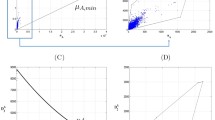Abstract
This paper concerns sequences of letters in which certain “distinguished” words are of interest. Such sequences arise as data in numerous fields including genetics and neuroscience. A probability distribution is given for the number of occurrences of a chosen word in a randomized sequence of letters. Such words are considered “favored” if they occur more than expected at random. Favored words have been discovered in nerve impulse trains and may reflect a neural coding scheme.
Similar content being viewed by others
Literature
Breen, S., M. S. Waterman, and N. Zhang, 1984. “Renewal Theory for Several Patterns”.J. appl. Prob. (to appear.)
Dayhoff, J. E. 1980. “Detection of Favored Patterns in Nerve Spike Trains.” (Ph.D. thesis), University of Pennsylvania.
Dayhoff, J. E. and G. L. Gerstein. 1978. “Pattern Detection in Spike Trains.”Biophys. Soc. Abs. M-POS-B17.
Dayhoff, J. E. and G. L. Gerstein. 1983. “Favored Patterns in Spike Trains, I. Detection, II. Application.”J. Neurophysiol. 49, 1334–1363.
deWachter, R. 1981. “The Number of Repeats Expected in Random Nucleic Acid Sequences and Found in Genes.”J. theor. Biol. 91, 71–98.
Gillary, H. L. and D. Kennedy. 1969. “Neuromuscular Effects of Impulse Pattern in a Crustacean Motoneuron.”J. Neurophysiol. 32, 607–612.
Goulden, I. P. and D. M. Jackson, 1979. “An Inversion Theorem for Cluster Decompositions of Sequences with Distinguished Subsequences.”J. Lond. math. Soc. 20, 567–576.
Goulden, I. P. and D. M. Jackson. 1983.Combinatorial Enumeration. New York: John Wiley.
Guibas, L. J. and A. M. Odlyzko. 1981. “String Overlaps, Pattern Matching, and Nontransitive Games.”J. comb. Theory. 30, 183–208.
Naus, J. I. 1974. “Probabilities for a Generalized Birthday Problem.”J. Am. Statist. Ass. 69, 810–815.
Naus, J. I. 1982. “Approximations for Distributions of Scan Statistics.”J. Am. Statist. Ass. 77, 177–183.
Perkel, D. H. and T. H. Bullock. 1968. “Neural Coding.”Neurosci. Res. Prog. Bull. 6, No. 3.
Ripley, S. H. and C. A. G. Wiersma. 1953. “The Effect of Spaced Stimulation of Excitatory and Inhibitory Axons of the Crayfish.”Physiologia. comp. Oecol. 3, 1–17.
Sugano, N. and M. Tsukada. 1978. “Effect of Correlated Adjacent Interspike Interval Sequences of the Excitatory Motor Axon on the Opening Movement of the Crayfish Claw Opener Muscles.”Biol. Cybern. 29, 63–67.
Wiersma, C. A. G. and R. T. Adams. 1950. “The Influence of Nerve Impulse Sequence on the Contractions of Different Crustacean Muscles.”Physiologia comp. Oecol. 2, 20–33.
Author information
Authors and Affiliations
Additional information
This article is dedicated to my mother, Margaret Oakley Dayhoff, whose enthusiasm encouraged me to pursue research in mathematical biology.
Rights and permissions
About this article
Cite this article
Dayhoff, J.E. Distinguished words in data sequences: Analysis and applications to neural coding and other fields. Bltn Mathcal Biology 46, 529–543 (1984). https://doi.org/10.1007/BF02459501
Issue Date:
DOI: https://doi.org/10.1007/BF02459501




